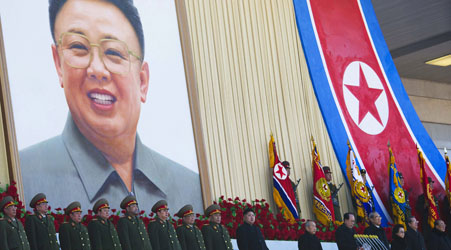North Korea's failed rocket launch prompts missile defense questions
 David Guttenfelder/AP file photo
David Guttenfelder/AP file photo
North Korea's failed rocket launch last week underscores the need for the United States to rethink missile defense spending, according to some lawmakers and arms control advocates.
Others, though, say that Pyongyang's continued efforts to strengthen its ballistic missile capabilities proves the U.S. defenses should receive even more money.
The United States' principal domestic defense against a long-range ballistic missile strike is justified primarily by a perceived threat from North Korea, observers note. The Ground-based Midcourse Defense program today is comprised of 30 land-based interceptors in California and Alaska that are designed to intercept missiles outside the Earth's atmosphere.
In January 2011, then-U.S. Defense Secretary Robert Gates said he believed North Korea could develop a missile capable of reaching the United States within five years. North Korea has repeatedly demonstrated an inability to launch such an attack, however, and the most recent failure on Friday -- when a rocket purportedly intended to carry a satellite into space broke apart shortly after liftoff - suggests Gates' prediction may have been exaggerated, according to critics.
The U.S. defense system, meanwhile, has not been tested in two years and the two most recent attempts failed. Testifying before a House panel last month, Missile Defense Agency chief Lt. Gen. Patrick O'Reilly said his organization would postpone reattempting a flight test carried out in December 2010, when an interceptor failed to hit an incoming dummy warhead.
In a statement to Global Security Newswire , Rep. John Tierney, D-Mass., said the failed North Korean launch on Friday was the latest indication that Congress must increase scrutiny over the U.S. missile defense program.
"Billions and billions of dollars continue to be spent on ballistic missile defense, yet the system still hasn't been fully or realistically tested to demonstrate its actual capabilities," said Tierney, the top Democrat on the House Oversight National Security Subcommittee. "I believe -- and independent experts agree -- that it is long past time for Congress to reconsider its approach to funding ballistic missile defense."
Tierney, who held hearings on the issue when Democrats controlled the House, said he would "keep pressing the issue."
The Obama administration in its fiscal 2013 budget request is proposing some cuts to missile defense spending as part of broader efforts to rein in government deficits. It is asking Congress for $9.7 billion for antimissile activities, which would represent a cut of $700 million, or 6.7 percent, from the current fiscal cycle. Total allocations for the next five budgets would be $47.4 billion .
The fiscal 2013 request for the GMD program is $903 million, according to Missile Defense Agency spokesman Richard Lehner. In fiscal 2012, Congress appropriated approximately $1.2 billion for the program, on which about $38 billion in today's dollars has been spent since the late 1980s.
Republicans, including presumed presidential nominee Mitt Romney, have said the proposed reductions call into question the Obama administration's commitment to homeland security. Rep. Michael Turner, R-Ohio, argued last month that cutting funding would not address the problems with the program and that a "more aggressive testing process" is needed .
Turner told GSN on Tuesday that the North Korean launch demonstrated a continued commitment by Pyongyang to develop a missile capable of reaching the United States and that it would be "irresponsible" to "count on sustained failure" by the isolated nation. "I can't imagine accepting someone's incompetence as being a reason for delaying" U.S. missile defense development, Turner said.
Rep. Howard McKeon, R-Calif., suggested in a Friday statement that, if anything, the failed North Korean launch that morning demonstrated a need for more missile defense spending.
"It appears North Korea has continued to pursue its efforts to strike the American people, while at the same time President Obama has degraded U.S. national missile defense," said McKeon, chairman of the House Armed Services Committee. "I call on the president to work with me and my committee to restore the investments in our national missile defenses as a prudent and necessary measure to protect the homeland."
White House spokeswoman Erin Pelton declined to comment, deferring the matter to the Defense Department. Lehner, the MDA spokesman, also declined to comment on the issue, saying by e-mail that "Congress decides how much is spent on missile defense, not" the agency.
Arms control advocates questioned the logic of Republican lawmakers regarding missile defense spending.
"Representative McKeon is asking for more money for a system that hasn't had a successful flight test in three-plus years," Kingston Reif, nuclear nonproliferation director at the Center for Arms Control and Nonproliferation, told GSN . "So far there's been no indication that more money will help the Missile Defense Agency fix the problems that caused the most recent flight test failures faster."
Overall, there have been eight successful intercept tests using Ground-based Interceptors in 16 flight tests since 1999. According to O'Reilly's March testimony, the agency will look to address the most recent failures by conducting a nonintercept flight test in July using upgraded technology. Hoping to have corrected any problems, the agency would then try a more challenging intercept test by the end of the year.
However, given the cost and technical difficulties associated with the ground-based defense system, the United States should rely instead on more cost-effective, test-proven interceptors such as the Standard Missile 3, Daryl Kimball, executive director of the Arms Control Association, told GSN .
In addition to being cheaper and more reliable, the interceptors offer greater versatility as they do not require the construction of stationary missile silos, but rather can be launched from mobile vehicles such as the Navy's Aegis destroyers, Kimball said. The SM-3 is designed primarily to defend against short and medium-range missiles, as opposed to long-range weapons, but North Korea has demonstrated that it "obviously can't put together" a successful long-range ballistic missile program in the near future, Kimball said.
Some advocates of a scaled-back missile defense program are not optimistic that North Korea's most recent failure will dramatically change the nature of debate in Washington. Ralph Cossa, president of the Pacific Forum of the Center for Strategic and International Studies, predicted the ground-based deterrence system will continue to enjoy support from its political backers.
"This is a religion to them," Cossa said. "All the facts in the world will not deter them."
Turner defended the reliability of the U.S. ground-based defense system, however, arguing that the first generation kill vehicle, known as Capability Enhancement No. 1, "is proven and works," and that much of the problems have been associated with the second generation, known as Capability Enhancement No. 2.
According to Lehner, however, only eight of the 14 intercept tests conducted on the first generation vehicle have been successful. The second generation has been tested twice and failed both times.
O'Reilly addressed the distinction between the two generations in 2011 testimony to Congress. The agency began developing the second generation "in 2005 based on obsolescence reasons -- parts manufacturers and so forth, not producing parts anymore that in the electronic systems," O'Reilly said.
While the second generation has failed in tests, "most of the missiles … deployed today are the earlier version," according to O'Reilly, and the agency continues "to have confidence in the system based on the data we've seen."
NEXT STORY: Congress Fiddles with the Defense Budget






